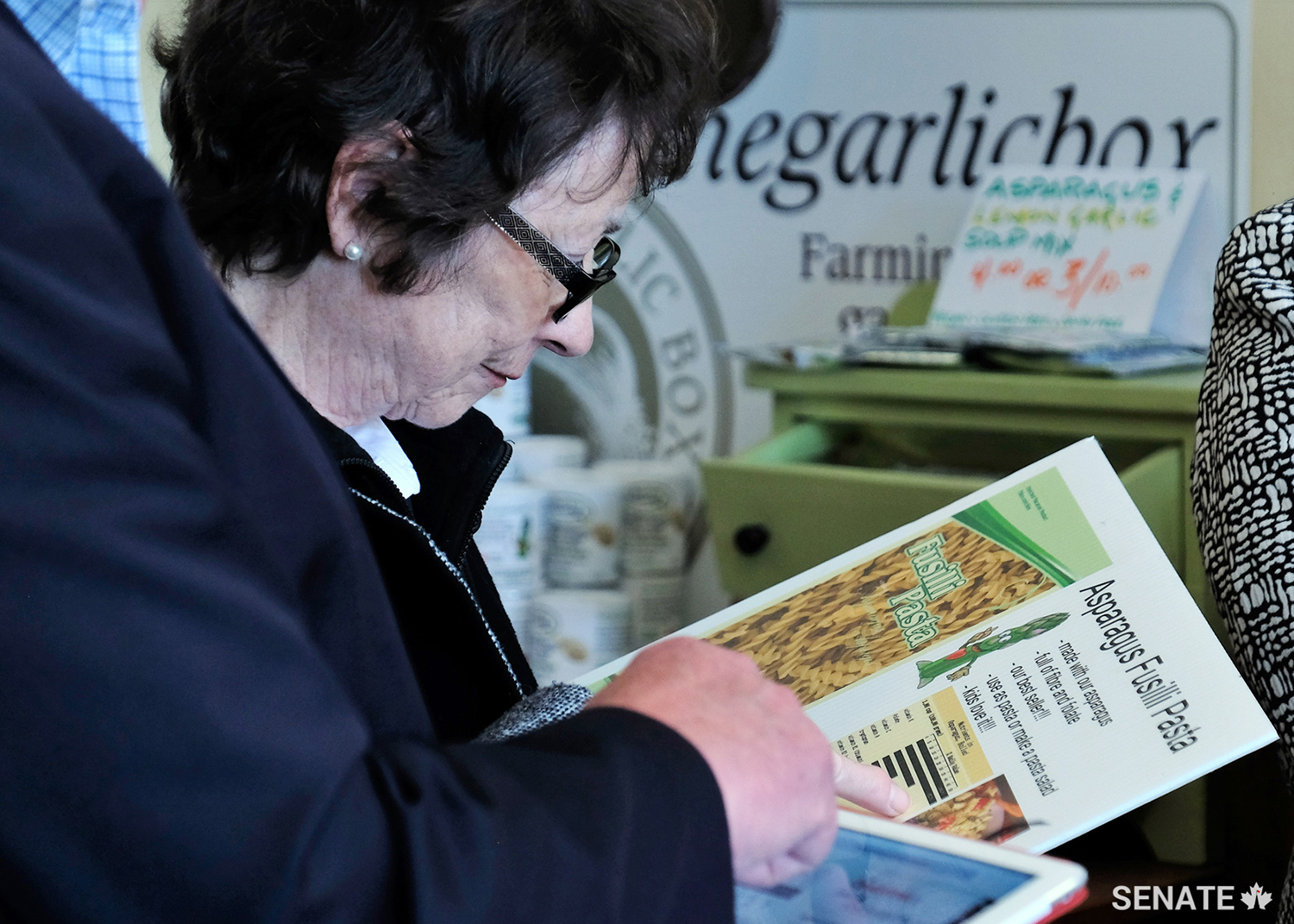The future in value-added food for Southern Ontario

Innovation in Canadian food takes place in the space between agriculture and industry: the value-added food sector. This is where businesses of all types — new and established, family-owned and multinational, large and small — develop their freshest ideas.
To get a taste of the latest in this fast-growing sector, the Senate Committee on Agriculture and Forestry spent a packed three days in Southern Ontario on fact-finding missions to businesses in North York, Mississauga, Hamilton, Guelph, Cambridge, Ayr and Waterloo.
“I think it’s important not just for jobs and employment, but also to add value to the local communities in Southern Ontario,” said Senator Victor Oh, reflecting on the importance of growing the value-added food industry in the region. “For instance, one of the apple farms we visited builds on the work of other businesses in the region.”
In North York, senators visited the Food Starter facility, where space and services are shared between businesses. This facility makes it possible for small businesses to focus on germinating ideas and getting their product to market before they have to worry about leasing large warehouses, planning for waste disposal or developing commercial-grade preparation and packaging processes.
 Members of the Senate Committee on Agriculture hear how the prices of fresh produce are established through an open market at the Ontario Food Terminal. More than 5,000 buyers source their fresh fruit and vegetables from the Ontario Food Terminal. Visit the Senate’s Facebook page for more photos.
Members of the Senate Committee on Agriculture hear how the prices of fresh produce are established through an open market at the Ontario Food Terminal. More than 5,000 buyers source their fresh fruit and vegetables from the Ontario Food Terminal. Visit the Senate’s Facebook page for more photos.

Many of the businesses are developing products that are new or seldom seen in Canada and come from first- and second-generation Canadians. Products like Japanese iced coffee, Mexican-style paleta ice pops and Middle Eastern kibbehs are being developed under one roof, using Canadian ingredients, Canadian suppliers and Canadian talent.
The Food Starter facility recently faced some uncertainty around its funding, highlighting one of the major challenges for the value-added food sector: limited support for local and small-scale innovation.
Innovation is nevertheless taking place. At Barrie’s Asparagus Farm & Country Market, asparagus is used to make pasta — and even soap.
“We have business leaders and innovators with brilliant ideas who want to make the most of Canada’s valuable resources,” said committee chair Senator Diane Griffin. “We need to develop a strong and collaborative connection between farms and the food industry in Canada.
“We should be clearing the field for them to reap what they are sowing.”
Read about the committee’s 2018 fact-finding missions to Quebec and British Columbia.
Related articles
Tags
Committee news
The future in value-added food for Southern Ontario

Innovation in Canadian food takes place in the space between agriculture and industry: the value-added food sector. This is where businesses of all types — new and established, family-owned and multinational, large and small — develop their freshest ideas.
To get a taste of the latest in this fast-growing sector, the Senate Committee on Agriculture and Forestry spent a packed three days in Southern Ontario on fact-finding missions to businesses in North York, Mississauga, Hamilton, Guelph, Cambridge, Ayr and Waterloo.
“I think it’s important not just for jobs and employment, but also to add value to the local communities in Southern Ontario,” said Senator Victor Oh, reflecting on the importance of growing the value-added food industry in the region. “For instance, one of the apple farms we visited builds on the work of other businesses in the region.”
In North York, senators visited the Food Starter facility, where space and services are shared between businesses. This facility makes it possible for small businesses to focus on germinating ideas and getting their product to market before they have to worry about leasing large warehouses, planning for waste disposal or developing commercial-grade preparation and packaging processes.
 Members of the Senate Committee on Agriculture hear how the prices of fresh produce are established through an open market at the Ontario Food Terminal. More than 5,000 buyers source their fresh fruit and vegetables from the Ontario Food Terminal. Visit the Senate’s Facebook page for more photos.
Members of the Senate Committee on Agriculture hear how the prices of fresh produce are established through an open market at the Ontario Food Terminal. More than 5,000 buyers source their fresh fruit and vegetables from the Ontario Food Terminal. Visit the Senate’s Facebook page for more photos.

Many of the businesses are developing products that are new or seldom seen in Canada and come from first- and second-generation Canadians. Products like Japanese iced coffee, Mexican-style paleta ice pops and Middle Eastern kibbehs are being developed under one roof, using Canadian ingredients, Canadian suppliers and Canadian talent.
The Food Starter facility recently faced some uncertainty around its funding, highlighting one of the major challenges for the value-added food sector: limited support for local and small-scale innovation.
Innovation is nevertheless taking place. At Barrie’s Asparagus Farm & Country Market, asparagus is used to make pasta — and even soap.
“We have business leaders and innovators with brilliant ideas who want to make the most of Canada’s valuable resources,” said committee chair Senator Diane Griffin. “We need to develop a strong and collaborative connection between farms and the food industry in Canada.
“We should be clearing the field for them to reap what they are sowing.”
Read about the committee’s 2018 fact-finding missions to Quebec and British Columbia.


